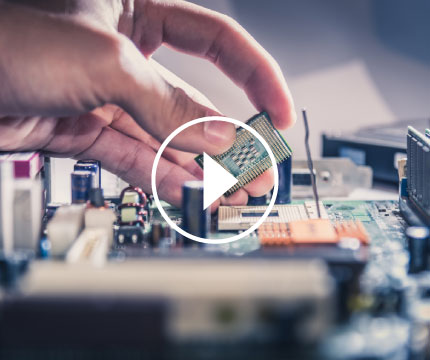PCIe Gen6 Training
Home > Course
PCIe gen6 Training
- Course Duration: 17 Hours
- 4.6 Star (Rating)
- 900+ (Student Enrolled till Now)
- About Course
- Demo Videos
- Fee Structure
- Curriculum
- Benefits of eLearning?
- Course Instructor
About Course
A course on PCIe (Peripheral Component Interconnect Express) Gen6 is typically designed to provide in-depth knowledge about the latest generation of the PCIe standard, its architecture, features, and implementation. ers of PCIe.
Demo Videos
Fee Structure
PAM4 Signaling
- Introduction to PAM4 (Pulse Amplitude Modulation with 4 Levels).
- Advantages over NRZ for achieving 64 GT/s.
- Signal integrity challenges (noise, jitter, crosstalk).
- Receiver equalization for PAM4.
- Error detection and correction mechanisms with PAM4.
Flit Mode and Non-Flit Mode
- Definition of Flit (Flow Control Unit) Mode.
- Differences between Flit and Non-Flit modes.
- Benefits of Flit Mode (lower latency, alignment).
- Transition from Non-Flit to Flit mode.
FEC (Forward Error Correction)
- Purpose and role of FEC in Gen6.
- Error correction for PAM4 signaling.
- Impact of FEC on latency and throughput.
Gen6 Topology
- Gen6 link width and lane configurations.
- Topology changes from previous generations.
- Support for multi-host and multi-root configurations.
Transaction Layer Updates
- Header Formats: Changes in header structure.
- Deferrable MWr Request: Concept and use cases.
- Common Packet Header Fields for Flit and Non-Flit Mode.
- Flit Mode TLP Header Type Encodings.
- Trailer Size Adjustments.
- Ordered Header Categories (OHC - A, B, C, E).
- Address Translation Services (ATS) updates.
- Routing Rules for TLPs.
- Transaction Processing Hints (TPH) Rules for Flit and Non-Flit Modes.
- Packet Header (PH) Updates.
- Steering Tag for efficient routing.
- TLP Header Format for Flit Mode.
- TLP Prefix Processing (Local and End-to-End).
- Process Address Space ID (PASID) functionality.
- Segment ID Field Introduction.
Data Link Layer Updates
- Shared Credit Pooling Mechanism.
- Updates in Data Link Control and Management State Machine (DLCMSM).
- DLLP (Data Link Layer Packet) Rules.
- DLLP Type Encodings for Gen6.
- Encoding Changes in DLLPs.
- Introduction of NOP and NOP2 DLLPs.
- Link Management DLLP Enhancements.
- New Data Link Feature DLLPs.
- Power Management DLLPs.
Physical Layer Updates
- Flit Mode Operations in Physical Layer.
- Power Management States: L0p and L0p Handshake using Link Management DLLP.
- L0s Updates.
- LTSSM (Link Training and Status State Machine) Updates.
- 1b/1b Encoding and Scrambling.
- Valid Encodings for Ordered Sets.
- Processing of Ordered Sets at 64 GT/s.
- Flit Mode Identification.
- Symbol Placement in 1b/1b Encoding.
- Transmit and Receive Side Operations for Flit Mode.
- Alignment at Block/Flit Level for 1b/1b Encoding.
- Gray Coding and Precoding Mechanisms.
- Decision Feedback Equalization (DFE).
- Data Stream in Flit Mode.
- FEC and Its Role in the Physical Layer.
- TLP and DLLP Bytes in Flit.
- Types of Flits (Idle, NOP, Payload).
- Implicit and Explicit Sequence Number Flits.
- Transmitter and Receiver Variables and Buffers in Flit Mode.
- Flit Replay and Retry Mechanism.
- Flit Sequencer Number Rules for Transmitter and Receiver.
- Handshake Phases:
- IDLE Flit Handshake Phase.
- Sequence Number Handshake Phase.
- Normal Flit Exchange Phase.
- Received ACK, NAK, and Discard Rules.
- Flit Replay Scheduling and Transmit Rules.
- Examples of Flit ACK/NAK/Replay Processing.
- Ordered Set Updates:
- TS0.
- Modified TS1 and TS2.
- EIOSQ and EIEOSQ.
- Half Scrambling Updates.
- Equalization Enhancements in Gen6.
- Clock Tolerance Compensation Updates.
- Alternate Protocol Negotiation.
- Retimer Enhancements.
Power Management Updates in Gen6
- Improvements in Active State Power Management (ASPM).
- Support for deeper power states.
- Dynamic power scaling features.
PCIe Message TLPs
- Updates in Message TLPs for Gen6.
- Enhanced signaling and messaging features.
PCIe Extended Capability Structures
- New extended capabilities introduced in Gen6.
- Modifications to existing capability structures for Flit Mode.
Benefits of eLearning?
- Access to the Instructor - Ask questions to the Instructor who taught the course
- Available 24/7 - VLSIGuru eLearning courses are available when and where you need them
- Learn at Your Pace - VLSIGuru eLearning courses are self-paced, so you can proceed when you're ready
Course Instructor
- Dedicated Trainer Accessible On Phone / Email / Whatsapp
- Trainer Exp: 15 Years

Course Highlights
- 1-1 mentor support
- Mentor guidance support for assignments
- Multiple mock interviews
- Dedicated live support sessions over weekends
TESTIMONIALS
What Our Students Says About Inskill

I enrolled in Frontend Verification training course, firstly about the syllabus, they teach a lot of things I have compared to other classes no-one teaches so many things as VLSIGURU has taught me. The live lectures happen on regular basis which is a combination of theory as well as practicals. The mentors are just awesome they have a very good knowledge about the modules and clear our every doubts.
The admins are very much co-operative and understandable and help you throughout the course.
The concepts taught are in a very simplified manner and every lecture is recorded.
Very much satisfied will recommend to any VLSI enthusiast

I joined this institute in summer after I was admissioned into IIT MADRAS, some of my seniors done training in this institute so they suggested me. When I was joining this institute my aim was to learn hardware language so that at the time of placements I should have some extra skills to stand out from the crowd and when the placement came I was so clear about my conceepts and the interviewers got impressed..they provided training live and I was able to clear my doubts and it also helped in courses in IIT which was a hectic thing for others.
The best thing about the institute is that the head of the institute teaches us one to one and make everything a cakewalk.
To be honest I didn't have any prior coding experience before
I am placed in Analog Devices Inclusive at very handsome package on Day 1 placements .
Thanks for the support.

I am very thankful to Owner of inskill Sreenivasa Reddy sir which have Excellent teaching skill and more powerful industry experience and good placement of these institute.
All mentor and trainer well experienced.
Verilog , system verilog ,UVM and project are in really depth with Lab and assignment session .
I appreciate efforts put up by all inskill team and specially appreciate to Sreenivasa Reddy sir.
I strongly recommend this course for students who want to start their journey in vlsi domain.

I completed Physical Design course in the institute and I would say VLSIGURU is the best institute at Bangalore. They have taught each concepts of PD in details and every faculty member is extremely supportive, whenever I had doubts they had it cleared for me which I liked the most. Also LAB classes are very good, they give tool access and you can explore on the tools like an adventurer. One of the greatest boon VLSIGURU has is they keep the live sessions recorded so that if anyone need to revisit the concepts again they can re-watch it.
FAQ
- Course presentations for all topics
- Session notes
- Lab documents with detailed steps
- User guides
- Exposure to standard bus protocols
- Exposure to Testbench component coding using SystemVerilog
Each session of course is recorded, missed session videos will be s
- Yes, You will have option to view the recorded videos of course for the sessions missed
- You will have option to repeat the course any time in next 1 year
- Yes, Course fee also includes support for doubt clarification sessions even after course completion
- You have option to mail you queries
- Option to meet in person to clarify doubts
